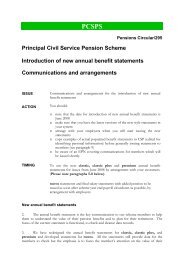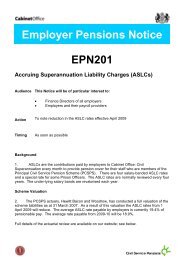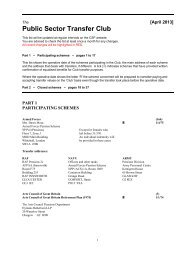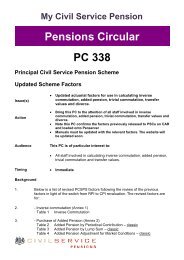Capability Reviews: Progress and Next Steps - The Civil Service
Capability Reviews: Progress and Next Steps - The Civil Service
Capability Reviews: Progress and Next Steps - The Civil Service
- No tags were found...
You also want an ePaper? Increase the reach of your titles
YUMPU automatically turns print PDFs into web optimized ePapers that Google loves.
• Building effective relationships <strong>and</strong> underst<strong>and</strong>ing the business model.We are seeing real progress in these areas, but still limited mostly to board <strong>and</strong>senior levels. Policy decisions that involve organisational change are still notroutinely informed by an underst<strong>and</strong>ing of current delivery models. Working-levelrelationships do not always add the value that they should to operationaleffectiveness.• Systems <strong>and</strong> processes. Departments are still unsure about which to use intheir routine relations with their delivery bodies, beyond those st<strong>and</strong>ards set inlegal <strong>and</strong> operating frameworks.What is the centre doing to build capability in delivery models?Various parts of the centre have been involved in work to support departments indeveloping a more evidence-based approach to delivery models.• PMDU is developing a delivery models tool to help departments with thechallenging task of strengthening their delivery model, ie improve the way inwhich the department <strong>and</strong> the rest of the delivery chain are set up to deliverparticular objectives.Case study: Strengthening the delivery model for achieving the socialexclusion PSA‘Earlier this year, the Social Exclusion Task Force was tasked with leading a crossgovernmentprogramme to tackle social exclusion. In August, whilst working on theDelivery Agreement for the new social exclusion PSA, the team decided to test <strong>and</strong>strengthen their delivery model further by piloting the new delivery models tool. Overthe next six weeks, the team participated in six workshops facilitated by PMDU, inwhich the external facilitators helped them to articulate more clearly what they weretrying to achieve <strong>and</strong> how they <strong>and</strong> their delivery chain were set up to achieve it,<strong>and</strong> then to identify weak parts of the model that needed to be strengthened.<strong>The</strong> product delivered three clear benefits to the team:• better shared underst<strong>and</strong>ing of their plans <strong>and</strong> the risks to delivery;• greater assurance that certain parts of their model were robust; <strong>and</strong>• evidence pointing to five weaker parts of the model where the team either neededto fill knowledge gaps or revise their plans. For instance, there was a clear need torevise some of the performance management arrangements.Feedback from the team on the tool itself was positive:“<strong>The</strong> workshops worked well...” “tough at times...” “questions posed by thefacilitators were very challenging but extremely helpful...” “its major value hasbeen in structuring our thinking on the delivery chain <strong>and</strong> identifying those areaswhere we need to do more work <strong>and</strong>/or improve our underst<strong>and</strong>ing.”’56COMMON CAPABILITY GAPS: PROGRESS AND NEXT STEPS
















